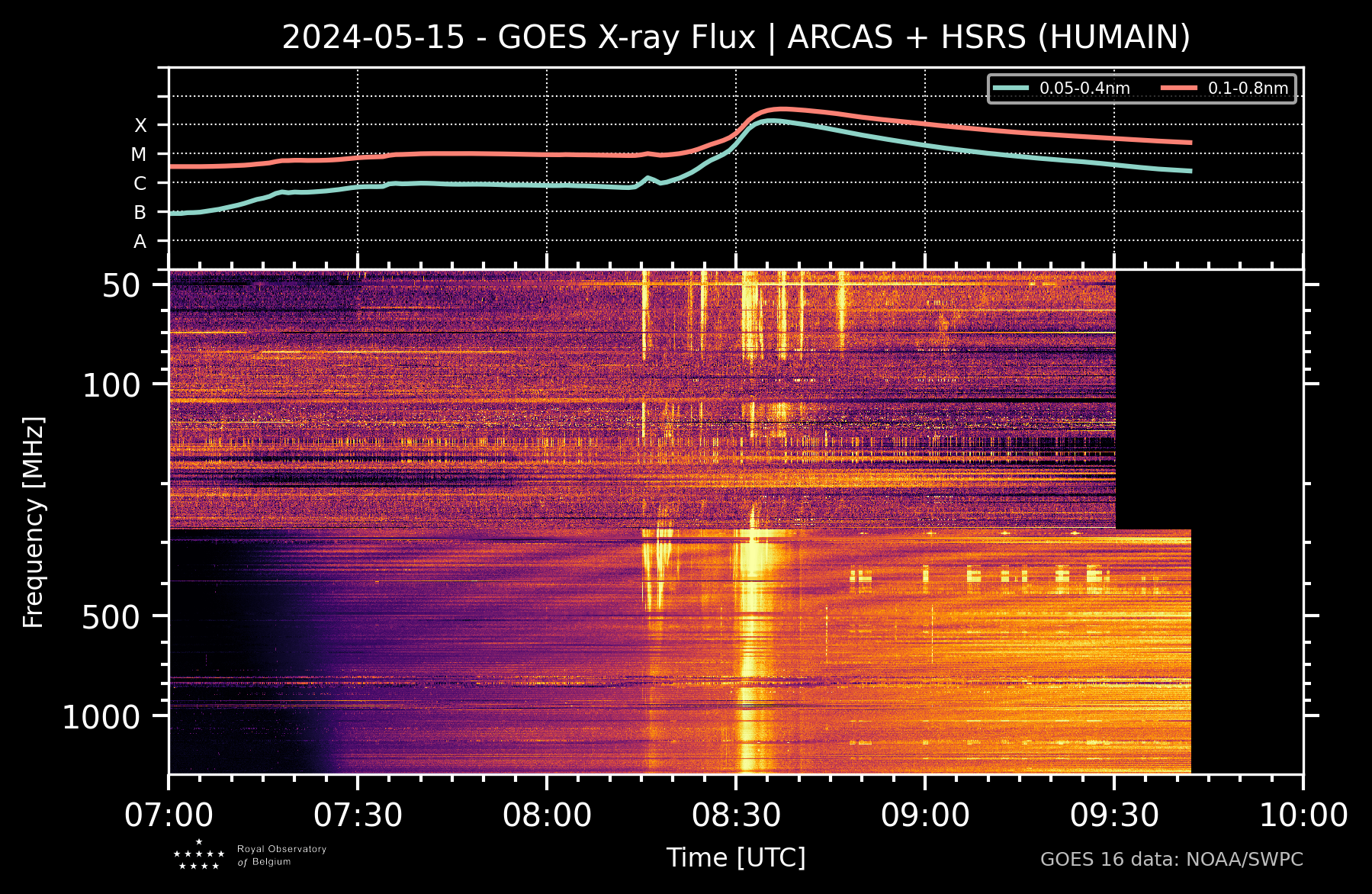Solar flare activity remains high with 2 X1.0 flares early on 8 May. The first X-class flare peaked at 01:41UTC and was produced by NOAA 3663 (located near the northwest solar limb), responsible for all the X-class flaring since last week. The major delta magnetic structure seems to be dissipating, and so the likelihood on another major flare from this region to be decreasing. The second X1.0 flare was produced by NOAA 3664, located near the central meridian in the southern solar hemisphere. This region has dramatically increased in size and magnetic complexity since 6 May, as can be seen in the clip underneath (6-8 May ; side-by-side). It shows a semi-transparent magnetogram overlaid on white light images of NOAA 3664. Red indicates positive magnetic polarity (field lines coming out of the Sun), blue represents negative magnetic polarity (field lines returning into the Sun). The continuous emergence of magnetic flux on several locations in the trailing portion of this region has resulted in no less than 5 major and 3 weak delta structures (annotated image). Further strong flaring is possible during the coming days.

The clip underneath shows flaring activity in extreme ultraviolet (SDO/AIA 094) on the Sun from 15:00UTC on 7 May until around 08:00UTC on 8 May. It shows NOAA 3663 and NOAA 3664 at work, with also flares produced by active regions just behind the east limb, heralding the return of the old active regions complex NOAA 3643/3645/3647 (see this STCE newsitem). Of note too is that the soft x-rays flux as measured by GOES has been continuously above the M1 level since 03:15UTC (chart). The proton flux has remained at background levels, despite the strong flaring activity that is going on since a week.

Today's coronagraphic imagery by SOHO/LASCO C2 shows a coronal mass ejection (CME) which may be interpreted as a full halo. However, as can be seen in this annotated image and the clip underneath, the CME may have had contributions from smaller CMEs related to eruptive activity in the aforementioned regions NOAA 3663, NOAA 3664, and the active regions behind the east limb. Nonetheless, the CME specifically associated with the X1.0 flare from NOAA 3664 seems to be wide enough to have an earth-directed component, in view also of the observed coronal wave (see base difference images of AIA 211 attached). Analysis by the SIDC space weather forecaster indicates an arrival at Earth by late 10 May.
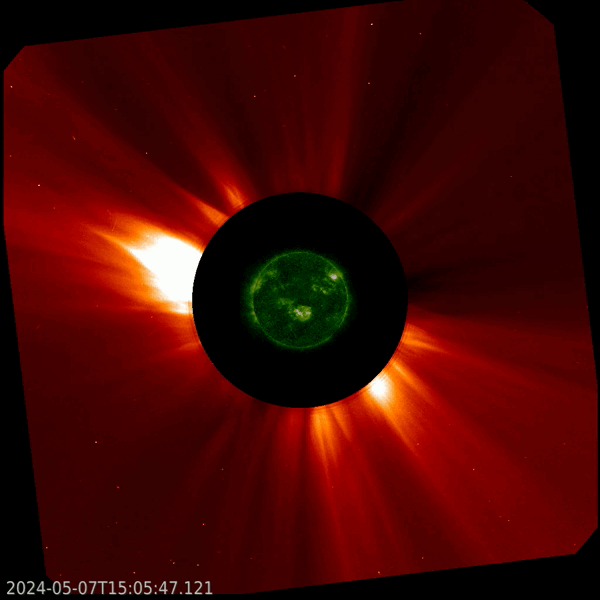
Space weather effects have been similar to the strong flaring activity of the last few days. High Frequency (HF) communications have been disturbed over the daylight side of the Earth (D-RAP). Advisories for disturbed HF Com has been sent by ACFJ (consortium of Australia, Canada, France and Japan) to the civil aviation through PECASUS. Magnetometer stations in India, Asia and Australia (Intermagnet (BGS)) recorded weak solar flare effects of a few nT at most. The Humain Radioastronomy Station shows prolonged disturbances at radio frequencies well after the X-class flares (spectrogram underneath; Type IV until 09:00UTC).
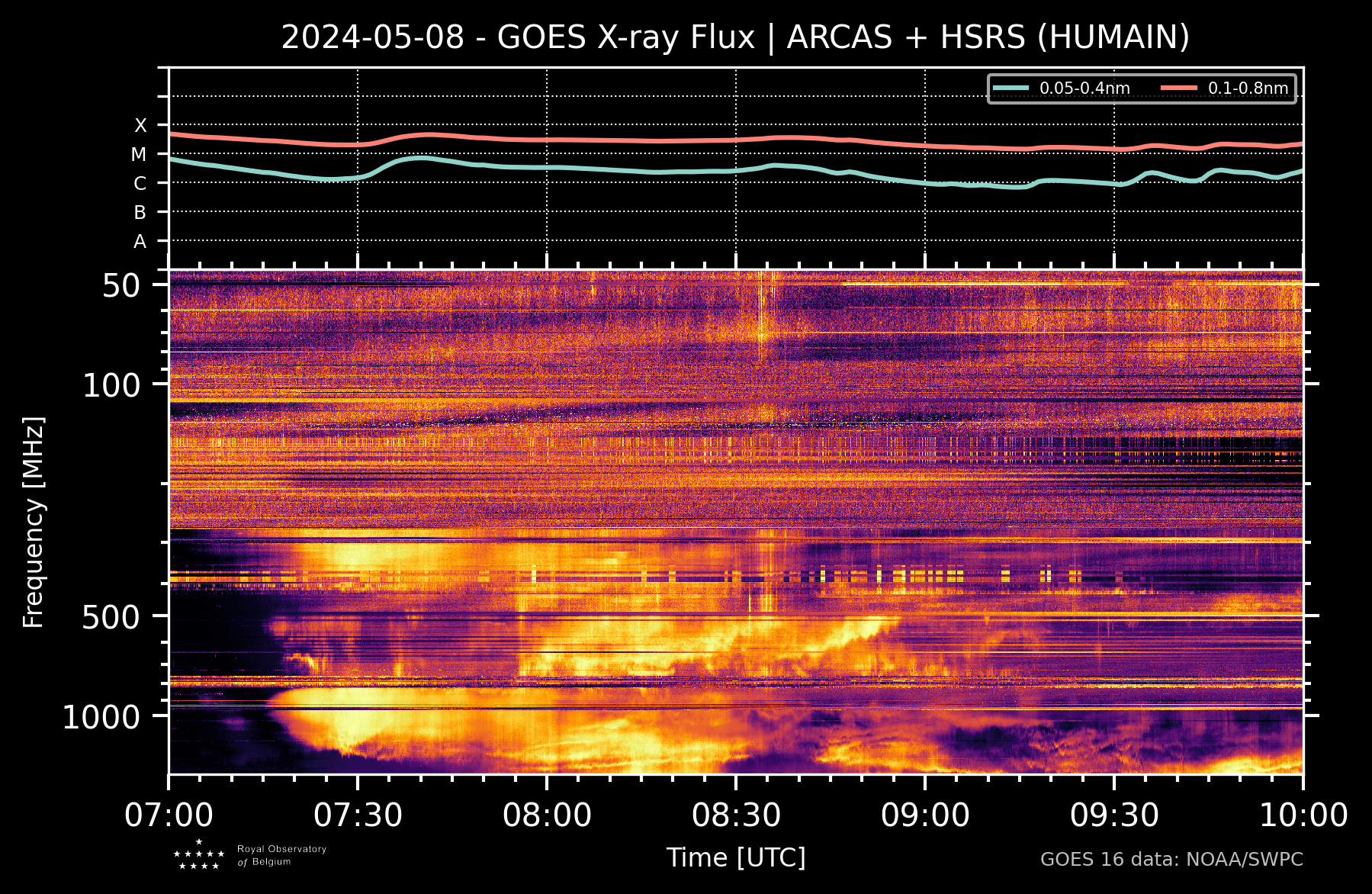
UPDATE 09 May 2024 at 11:30UTC - NOAA 3664 was the source of 2 X-class flares over the last 24 hours. The first was a long duration X1.0 flare peaking at 21:40UTC on 08 May. This sunspot region is shaping up to be one of the largest so far this solar cycle and was an easy naked eye target (using eclipse glasses). The X1 flare was associated with a Tenflare (1000 sfu at 10.7 cm radio flux), and a full halo CME with a plane-of-the-sky speed around 600 km/s. The second one was a X2.2 flare peaking at 09:13UTC on 09 May. It was associated with a Type II radio burst, but standing by coronagraphic imagery. The SIDC forecaster is analyzing for direction and arrival time. The Humain Radioastronomy Station shows a Type IV following the Type II radio burst and lasting for about 1.5 hours (from shortly after 09:00UTC until about 10:30 UTC - see the spectrogram underneath). Radar and GNSS frequencies may have been affected, with strong fluxes observed at radar and GNSS frequencies, resp. in excess of 100.000 and 10.000 sfu. The greater than 10 MeV proton flux (GOES) has -finally- started a modest enhancement, but still remains well below the alert threshold.
Other space weather effects have been similar to the strong flaring activity of the last few days. High Frequency (HF) communications have been disturbed over the daylight side of the Earth (D-RAP). Advisories for disturbed HF Com has been sent by ACFJ (consortium of Australia, Canada, France and Japan) to the civil aviation through PECASUS. Some magnetometer stations in India, Asia and Australia (Intermagnet (BGS)) recorded weak solar flare effects of a few to 10 nT. The imagery underneath show the X2 flare in H-alpha through a 4cm H-alpha telescope at the time of the flare maximum (see also GONG and USET), and a radio spectrogram by Humain of the radio bursts associated with the X2 event (the GOES x-ray flux is on top).
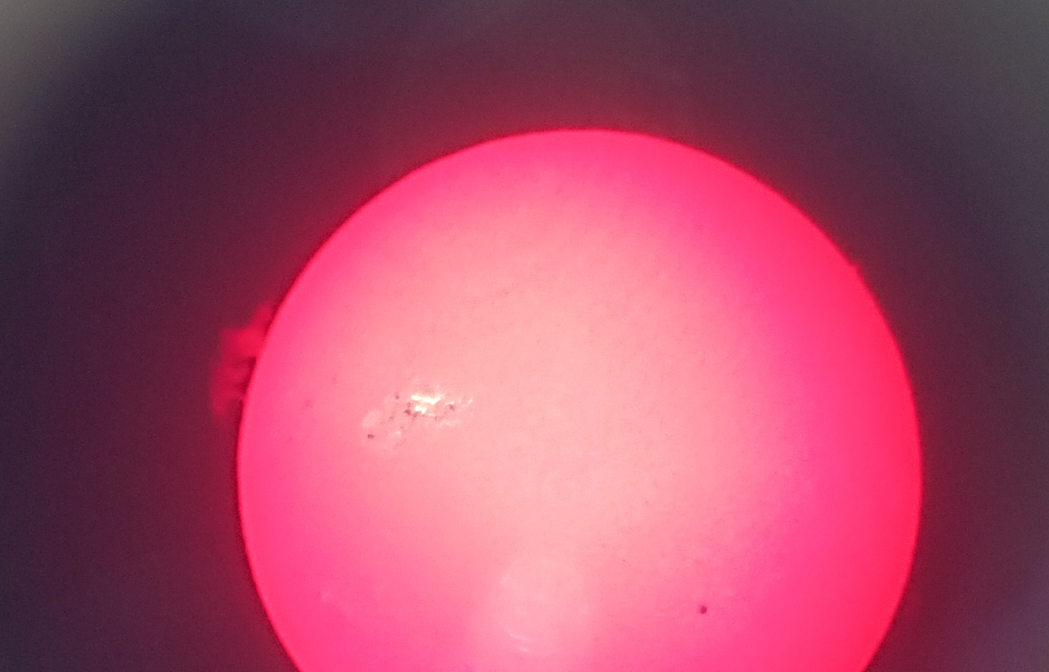
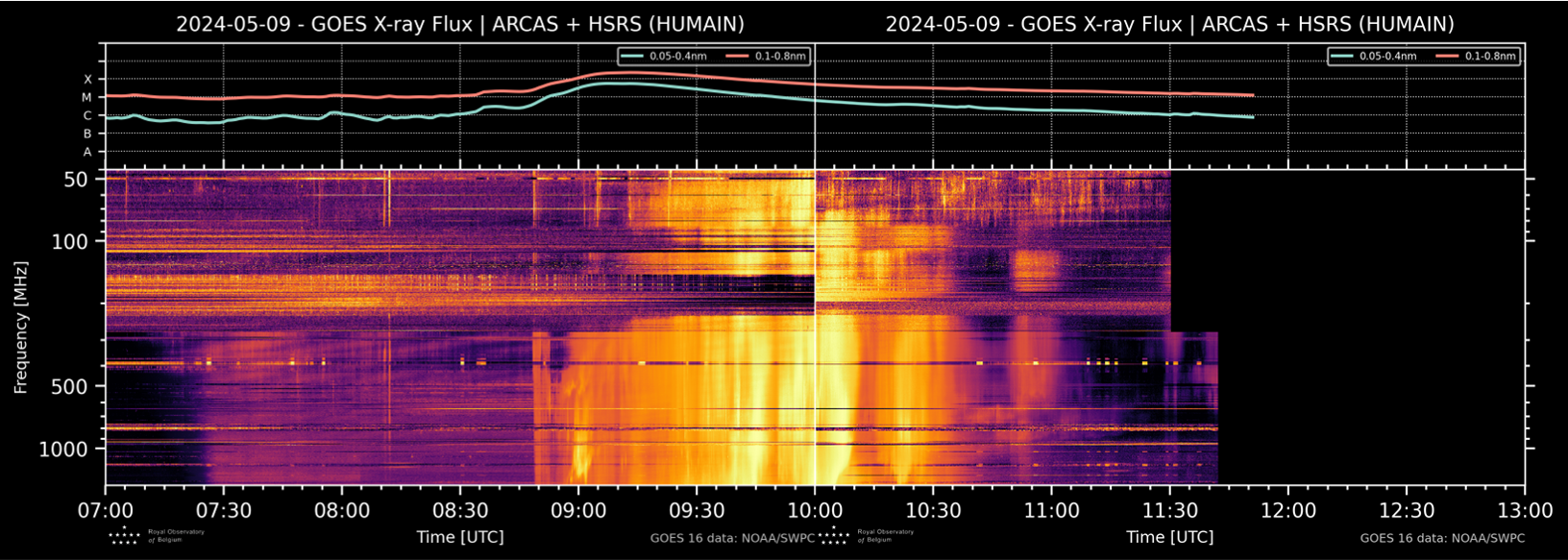
UPDATE 10 May 2024 at 06:30UTC - NOAA 3664 was the source of yet another X-class flare. The X1.1 peaked at 17:44UTC on 09 May. It was associated with strong radio bursts along the entire range of observed radio frequencies. STEREO-A indicates anoher earth-directed CME might be associated with the eruption. The greater than 10 MeV proton flux (GOES) remains enhanced but its current value of 1 pfu is well below the alert threshold. The SIDC forecaster expects the arrival of the CMEs associated with the flaring activity of the last few days starting from noon today throughout the whole weekend. The quick succession of the CMEs may allow for interaction ("CME cannibalism") and result in stronger geomagnetic storms than if they would arrive separately. The SIDC expects moderate to severe geomagnetic storms (Kp: 6-8), meaning that aurora may be visible and certainly photographed from Belgium. Power grids (higher latitudes), HF radio communications, satellite operations and GNSS applications may be affected.
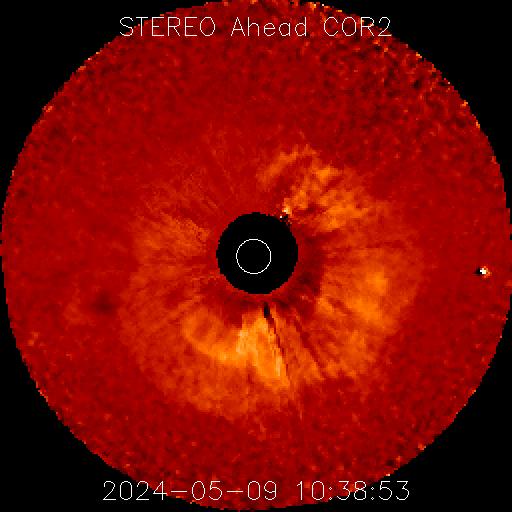
UPDATE 10 May 2024 at 18:30UTC - NOAA 3664 was the source of yet another X-class flare. The X3.9 peaked at 06:54UTC on 09 May. It was associated with mild radio bursts along the entire range of observed radio frequencies. STEREO-A indicates anoher earth-directed CME might be associated with the eruption. The partial halo CME is expected to arrive by 12 May (SIDC). The greater than 10 MeV proton flux (GOES) exceeded the alert threshold at 13:35 UTC and is currently (17:50UTC) around 200 pfu. Further modulation over the next few days is likely due to more strong flaring and from the passage of interplanetary CMEs from the last few days. The effects remain mostly restricted to disturbed HF Com at the polar regions ("Polar Cap Absorption"), as the higher energy proton fluxes remain at background levels. A new webpage has been opened to follow the evolution of the geomagnetic activity.
UPDATE 11 May 2024 at 06:30UTC - NOAA 3664 was the source of yet another X-class flare. The X5.8 peaked at 01:23UTC on 11 May (see the white light/EUV overlay underneath). This was the strongest flare produced by NOAA 3664 so far. Owens Valley nicely captured the associated radio bursts (spectrogram underneath - note the units are in GHz). STEREO-A indicates anoher earth-directed CME might be associated with the eruption, though the bulk seems to be directed away from our planet. Precise direction and arrival time are being analyzed by the SIDC forecaster. The greater than 10 MeV proton flux (GOES) exceeded the alert threshold at 13:35 UTC and reached a mximum of 207 pfu at 17:45UTC. Following the X5 flare, a new proton event started at 02:10UTC (11 May). Importantly, the higher energy proton fluxes have increased too (chart underneath). The greater than 100 MeV proton flux reached the alert threshold at 02:10UTC and is currently near 6 pfu. This may shape up as a weak Ground Level Enhancement (GLE). Further modulation over the next few days is likely due to more strong flaring and from the passage of interplanetary CMEs from the last few days. The effects remain mostly restricted to disturbed HF Com at the polar regions ("Polar Cap Absorption"), with a potential for radiation hazard (astronauts, polar flights) if the high energy proton fluxes continue to increase.

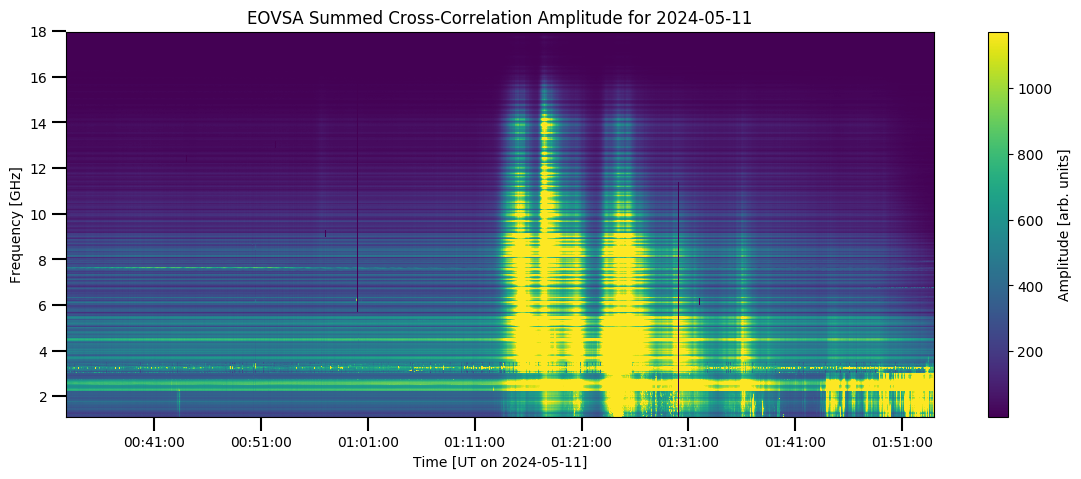
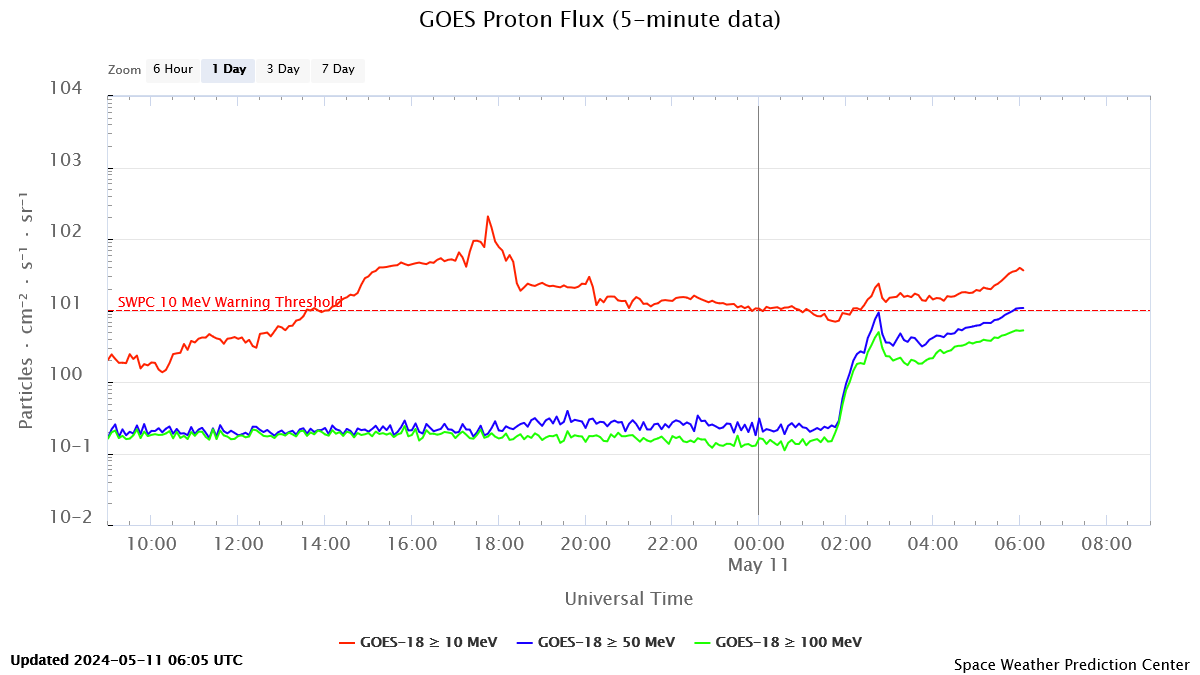
UPDATE 11 May 2024 at 17:30UTC - NOAA 3664 was the source of yet another X-class flare. The X1.5 flare peaked at 11:44UTC on 11 May (see the SDO white light/EUV overlay underneath). STEREO-A and SOHO coronagraphic imagery indicates there was no CME associated with this event. The Humain Solar Radioastronomy Station also did not record any obvious radio burst in the 50-1500 MHz range during that time (Map). Obviously, further strong flaring from NOAA3664 remains possible during the next few days. The greater than 10 MeV proton flux (GOES) peaked at 09:10 UTC and reached a mximum of 116 pfu. It is currently still very close to the 100 pfu level. Following the X5 flare from earlier today, a new proton event started at 02:10UTC (11 May). The greater than 100 MeV proton flux has reached a maximum of 7.7 pfu at 07:10UTC, too weak to develop into a Ground Level Enhancement (GLE). Further modulation of the proton fluxes over the next few days is likely due to more strong flaring and from the passage of interplanetary CMEs from the last few days. The effects from this solar radiation storm remain mostly restricted to disturbed HF Com at the polar regions ("Polar Cap Absorption"), with a potential for radiation hazard (astronauts, polar flights) if the high energy proton fluxes should increase. Note the CME moving to the northeast in the coronagraphic image underneath (12:18UTC) is related to solar activity beyond the Sun's east limb and has no earth-directed component..
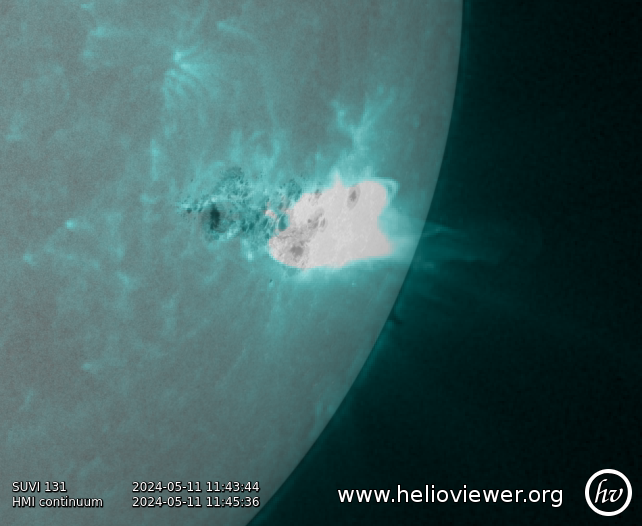
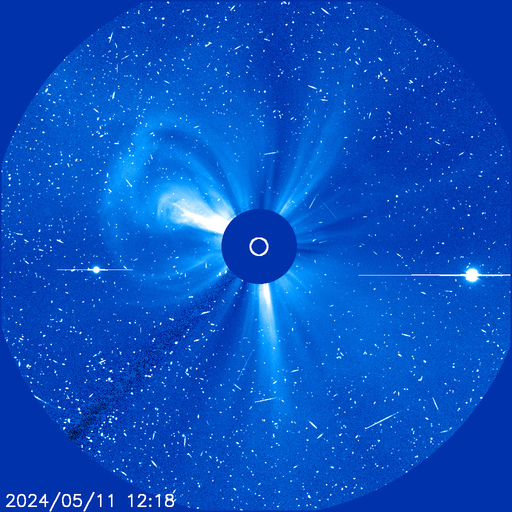
UPDATE 12 May 2024 at 18:30UTC - Another day, another X-class flare... NOAA 3664 was the source of an X1.0 flare that peaked at 16:26UTC on 12 May. Owens Valley nicely captured the associated radio bursts (spectrogram underneath - note the units are in GHz), indicating especially the super high frequencies (3-30 GHz) were affected. No coronal dimming was observed in EUV imagery (Solar Demon), and no Type II radio burst has been reported so far. Standing-by for STEREO-A and SOHO coronagraphic imagery to confirm or rule out the association with a CME. Obviously, further strong flaring from NOAA3664 remains possible during the next few days. The proton event for the greater than 10 MeV proton flux (GOES) ended at 12:40UTC today. Further modulation of the proton fluxes over the next few days remains possible due to more strong flaring and from the passage of interplanetary CMEs from the last few days.
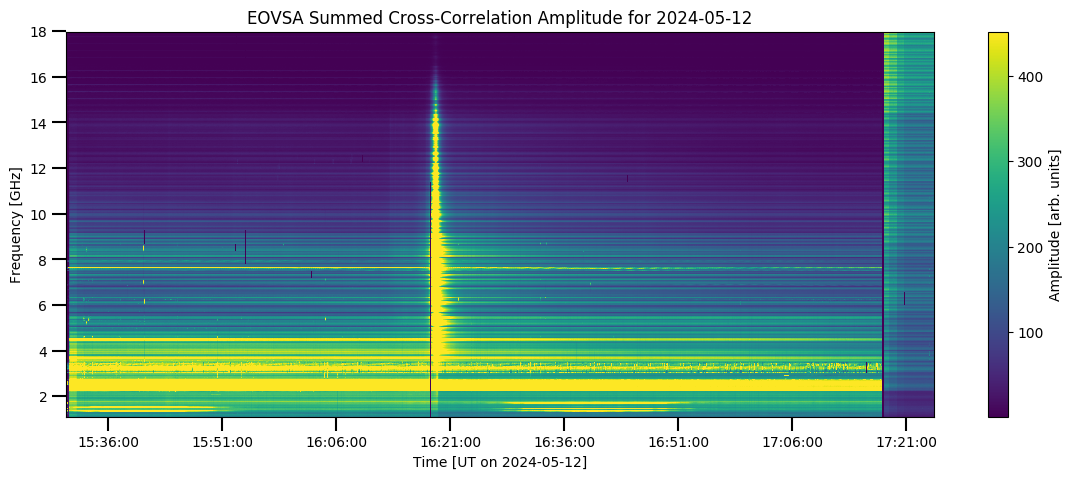
UPDATE 14 May 2024 at 09:30UTC - Bad boy NOAA 3664 produced an X1.7 flare peaking at 02:09UTC. It was associated with a CME that is not earth-directed. A more important eruption took place yesterday 13 May when a long duration M6.6 flare peaked at 09:44UTC. A proton event started at 14:00UTC and reached a maximum of 121 pfu on 14 May at 05:05UTC (GOES). The greater than 100 MeV proton flux remained at background levels. The eruption was associated with a full halo CME that is expected to deliver a glancing blow to the earth environment late on 14 May. A minor to strong geomagnetic storm is expected (SIDC). As NOAA 3664 is now almost completely behind the Sun's west limb, chances on strong flaring during the next 24 hours are diminishing (not zero!). Associated CMEs are not thought to have an earth-directed component. A proton event from eruptive activity by NOAA 3664 remains possible.
Space weather effects from the x-ray flares were limited to some minor disturbances of HF Com on the Earth's dayside (DRAP). The effects from the proton event remain mostly restricted to disturbed HF Com at the polar regions ("Polar Cap Absorption"), which is still ongoing. Advisories to the civil aviation for disturbed HF Com (from the solar flares as well as for the PCA) have been sent by ACFJ (consortium of Australia, Canada, France and Japan) and PECASUS.
The clips underneath show EUV imagery from the M6 and X1 flare, with yellow colours reflecting temperatures around 700.000 degrees (GOES/SUVI 171) and blue representing temperatures of multi-million degrees (GOES/SUVI 094). The hottest parts of the flare suggest the presence of supra-arcade downflows (SAD). These features have been discussed in detail in this STCE newsitem, providing also many more examples of SADs. The second clip shows the associated CMEs, with coronagraphic images (SOHO) overlaid on EUV imagery by GOES/SUVI.


UPDATE 14 May 2024 at 15:00UTC - NOAA 3664 can't help it: this active region has produced yet another X-class flare! The X1.2 flare peaked on 14 May at 12:55UTC (GOES). This is already the 2nd X-class flare today, though NOAA 3664 has now fully rotated over the west limb. There remains a chance for another X-class flare from this region during the next 24 hours. The proton event that started at 14:00UTC on 13 May following the M6 flare is still in progress. The proton fluxes (greater than 10 MeV and 100 MeV) have not shown a renewed increase so far following the most recent X-class flare (GOES). A proton event from eruptive activity by NOAA 3664 remains possible. Also standing-by coronagraphic imagery, but it is very likely that any associated CME is not earth-directed.
Space weather effects from the x-ray flares were limited to some minor disturbances of HF Com on the Earth's dayside (DRAP). The effects from the proton event remain mostly restricted to disturbed HF Com at the polar regions ("Polar Cap Absorption"), which is still ongoing. Advisories to the civil aviation for disturbed HF Com (from the solar flare as well as for the PCA) have been sent by PECASUS.
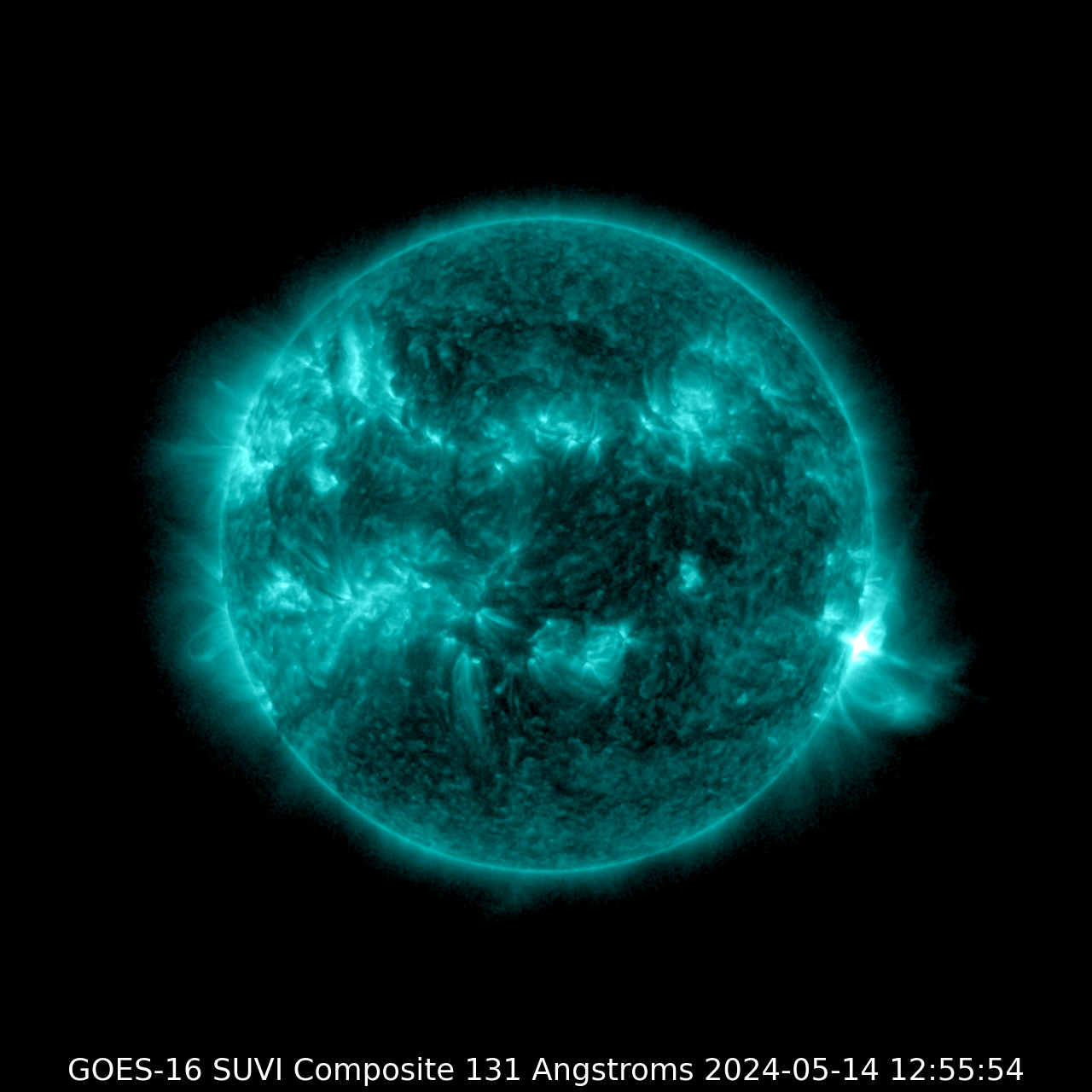
UPDATE 14 May 2024 at 20:00UTC - NOAA 3664 just produced the strongest solar flare so far this solar cycle (SC25). The X8.7 peaked at 16:51UTC (GOES). This is already the 3rd X-class flare today, though NOAA 3664 has now fully rotated over the west limb. There remains a chance for another X-class flare from this region during the next 24 hours. The proton fluxes (protons with energies greater than 10 MeV and 100 MeV) have not shown an increase so far over and above the already ongoing proton event that started at 14:00UTC on 13 May (GOES). A proton event from eruptive activity by NOAA 3664 remains possible. Coronagraphic imagery from STEREO-A/COR2 shows a partial halo CME with no earth-directed component (image underneath). Another CME associated with an M4.4 flare in 3680 (northeast solar quadrant) was also associated with a partial halo CME (image). Standing-by more coronagraphic imagery and analysis by the SIDC forecaster for any earth-directed component.
Several magnetic observatories in North- and South America (Intermagnet (BGS)) reported a solar flare effect (SFE), i.e. one or more components of the magnetic field strength showing a spike around the time of the flare's peak due to ionospheric enhancement by the flare's x-ray and (E)UV radiation (also known as a "magnetic crochet"). The strength of the SFE varied between a few to 20 nT, with San Juan up to 28 nT. For comparison, the Carrington flare showed an SFE of 110 nT (Cliver & Svalgaard, 2004). OVSA radio spectrogram showed that the entire radio frequency range was strongly, but only briefly affected. A Tenflare of 1100 sfu was observed for 10.7cm solar radio flux; well above the required doubling of the pre-flare value of around 200 sfu (NOAA/USAF network). High Frequency (HF) communications have been disturbed over the daylight side of the Earth (D-RAP; Map). Advisories for disturbed HF Com has been sent to the civil aviation by PECASUS.
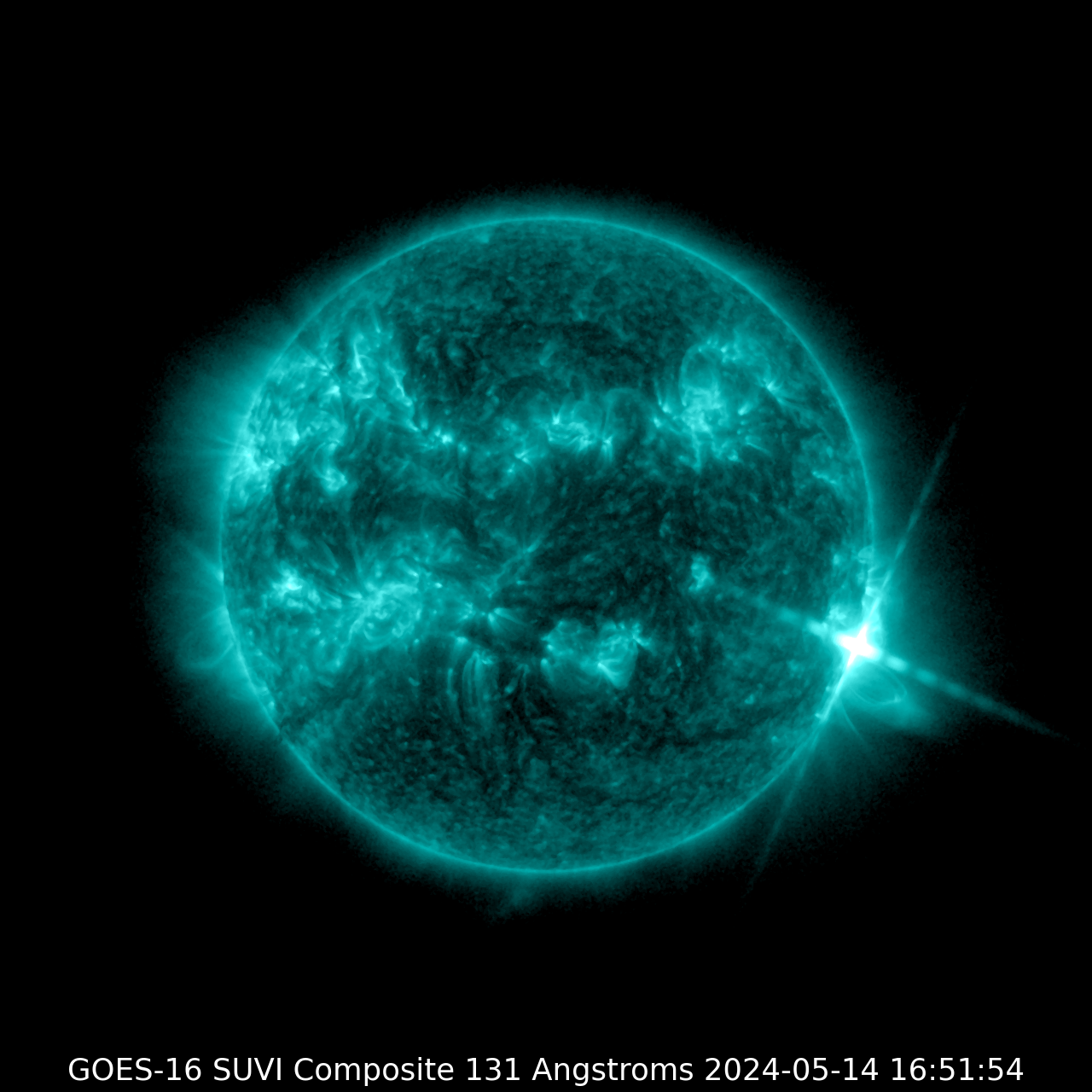
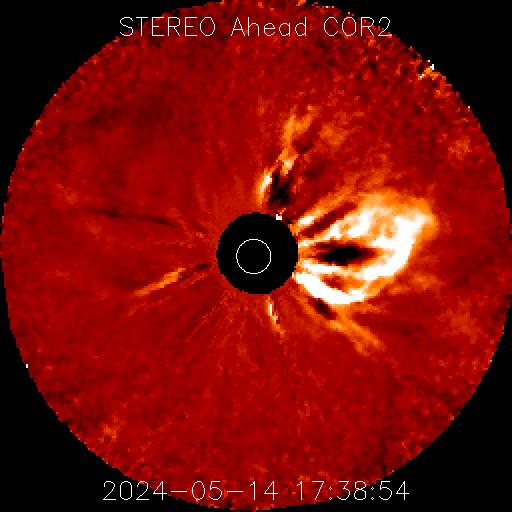
UPDATE 15 May 2024 at 10:30UTC - Everything must go! NOAA 3664 is having a yard sale of its X-class flares. This I-don't-know-when-to-stop superactive region just produced another X-class flare from behind the solar limb, this time an X3.4 peaking at 08:37UTC (GOES). There remains a chance for another X-class flare from this region during the next 12-24 hours. The proton fluxes (protons with energies greater than 10 MeV and 100 MeV) have not shown an increase so far over and above the still ongoing proton event that started at 14:00UTC on 13 May (GOES). A proton event from eruptive activity by NOAA 3664 remains possible. Coronagraphic imagery from STEREO-A/COR2 shows a partial halo CME with no earth-directed component (image).
High Frequency (HF) communications have been disturbed over the daylight side of the Earth (D-RAP; Map). Advisories for disturbed HF Com have been sent to the civil aviation by PECASUS. No obvious solar flare effect (SFE) is distinguished in the available recordings from the dayside magnetic observatories (Intermagnet (BGS)). An SFE happens when one or more components of the magnetic field strength show a spike around the time of the flare's peak due to ionospheric enhancement by the flare's x-ray and (E)UV radiation (also known as a "magnetic crochet"). Radio bursts were observed over the entire frequency range (245 MHz to 15.4 GHz), with a Tenflare of 450 sfu for 10.7cm solar radio flux (2695 MHz); well above the required doubling of the pre-flare value of around 200 sfu (NOAA/USAF network). The Humain Radioastronomy Station recorded mostly Type III radio bursts associated with this X3 flare (upper curves), as shown in the diagram underneath.
